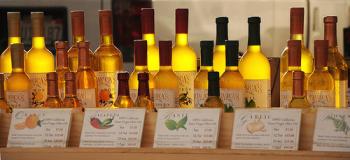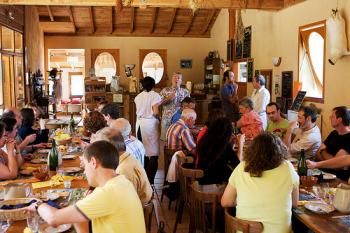Posted on April 18, 2011
In a previous post I discussed the rise of food heritage as a hot new topic. In this blog post I'll discuss how this trend has played out in the Lists of the Intangible Heritage Convention.

The inscription of the three elements on the Representative list has not been easy. Various individuals and organizations have complained about the nominations, either in the press or to the Intergovernmental Committee responsible for evaluating the nominations under the Convention. According to media reports, some of the food-related nominations were rejected on their first application for inscription because they were too broadly defined. There is little precedent for defining food specifically as heritage in the professional context or in the Convention. No ICH domain is designated specifically for food in the Convention, although domains such as performing arts and craftsmanship are mentioned as Article 2. This list of ICH domains in the Convention is deliberately not exhaustive, however. There was thus some discussion as to what kinds of food preparation and consumption would be defined as intangible heritage, and thus fall within the ambit of the Convention. Should food-related ICH elements all relate to specific events such as festivals or feasts? Or can everyday foodways be included? An expert meeting was held on the topic in April 2009 which paved the way for the three successful nominations to the list.

A second major criticism in press around the nominations is that there seems to be a direct link between countries' food-related nominations to the Intangible Heritage lists and more general promotional campaigns around tourism and trade. Of course, many local products are protected by applying trademarks, geographical indications and other forms of intellectual property protection. Rules governing the labelling of goods, for example, now prevent products being labelled as 'port', 'champagne', 'parmesan' or 'feta' if they do not come from a specific region. These intellectual property protections are unaffected by any nomination to the lists of the Intangible Heritage Convention.
Nevertheless, it seems clear that inscription on the lists of the Convention does give a campaign to promote local food products some added status. Sarkozy, the French President, used the opportunity of the French nomination to call French cuisine 'the best in the world', nearly derailing the bid before it was successful. The Mediterranean diet is specifically being promoted as a healthy diet in the publicity around the Italian, Spanish, Greek and Moroccan nomination to the Representative List. One British commentator complained that elevating the Mediterranean Diet as heritage undermined support for local foods in Britain. This trend is ironic in some ways because nomination to the lists of the Intangible Heritage Convention are not intended to suggest that certain forms of intangible heritage are more significant or more unique than others, unlike nominations to the World Heritage List.
The food elements mentioned in the Mediterranean Diet inscription are major food exports from the nominating countries, such as olive oil and pasta. The Greek, Italian and Spanish ministries of agriculture played a role in promoting and publicising their bids for inscription of the Mediterranean Diet on the Representative list. The Italian Ministry of Agricultural Food and Forestry representative, rather than the Ministry of Culture, signed the nomination form on behalf of the State Party. The Italian farm lobby Coldiretti organized a 'maxi-spaghettata' to celebrate the inscription the morning of its announcement. Coldiretti noted rising exports of Italian products in the Mediterranean Diet and said that promoting the diet also promoted food and wine tourism in Italy. After the nomination, the Greek Agriculture minister was reported as saying that they were setting up a farm centre in the Peloponnese mountains to promote the diet. Olive oil is one of Greece's main exports and they are trying to attract interest from the Chinese market.
This year, France unveiled a global campaign called 'So French So Good'Â in February, building on the inscription of 'French gastronomical meal' on the Representative List. The campaign is designed to promote France's food export trade, four years after Germany overtook it as Europe's top food exporter. France plans to showcase its food products around the world with a logo featuring a dinner fork interlinked with a wine glass. The campaign will send special booths in kit form for display in 170 exhibitions around the world, focusing on neighbouring EU countries, China, the United States, Japan, Russia and the United Arab Emirates. The campaign aimed at boosting a sector employing 250,000 people in France, will cost $2.71 million of public funding and involve 4,000 companies.
The Mexican nomination seems to be linked to tourism rather than the food trade. The Conservatory of Mexican Gastronomic Culture and the Don Vasco Cultural and Tourism Route project will work with traditionally-trained cooks to set up small enterprises and provide training in business administration, hygiene and marketing in a project to create 'culinary hubs' around the country, promoting local cuisines.
Is this so surprising?
Governments, and other interest groups, use heritage as a vehicle for promoting national identity, tourism and trade all the time. Think Robben Island, Vredefort dome, or the Great Wall of China. All heritage is a construct - we just have to be responsible, critical and self-reflective about how we represent and use the past for engagement with the present. We're always trying to link heritage and development, even from within the heritage field, so that is nothing new. Food heritage certainly has commercial value, and the economic benefits from the promotion of heritage food products may be much larger than tourism income, because they are not limited to income generated from visitors to a site.
Done in a responsible way, promoting local products as food heritage may have spin-offs for health and environmental sustainability as well as the economy. But we need to be vigilant that in this process, food heritage does not simply become a new form of marketing, in which historical fact and current social practice are blatantly and actively distorted to further regional or national commercial interests.
Food nominations to the Intangible Heritage lists need to be better formulated and links to other initiatives more carefully framed and conceived. Improving the food nominations will require some further thought about the nature of food as heritage, how it should be defined and how it can be 'safeguarded' without preventing innovation and change. Inscription on lists of the Convention are not intended to fossilise foodways by preventing innovation. But there is as yet little discussion about how much change, and what kind of change, would be permissible in the case of specific food elements. Also, there would need to be discussion about how agricultural and cultural policies, transmission of cooking skills and other safeguarding measures could support continued practice of local foodways without focusing exclusively on large commercial enterprises.
Heritage professionals, academics and other interest groups need to start engaging critically with the question of food as heritage to ensure that these problems are addressed.
Harriet Deacon, consultant correspondent to the Archival Platform, is currently based in the UK where she has been involved in writing training materials for UNESCO about the Intangible Heritage Convention. A medical historian by training, she was lead author of The Subtle Power of Intangible Heritage, and was on the expert panel developing the South African draft ICH Policy in 2007-2009. The opinions expressed in this blog are personal, and not attributable to any organization.
Picture credits:
Repas by Laurent Jegou
http://www.flickr.com/photos/laurent_jegou/2610445519/sizes/l/in/photostream/
Olive Oil by Ozium 101 - http://www.flickr.com/photos/ozium101/5123424222/lightbox/